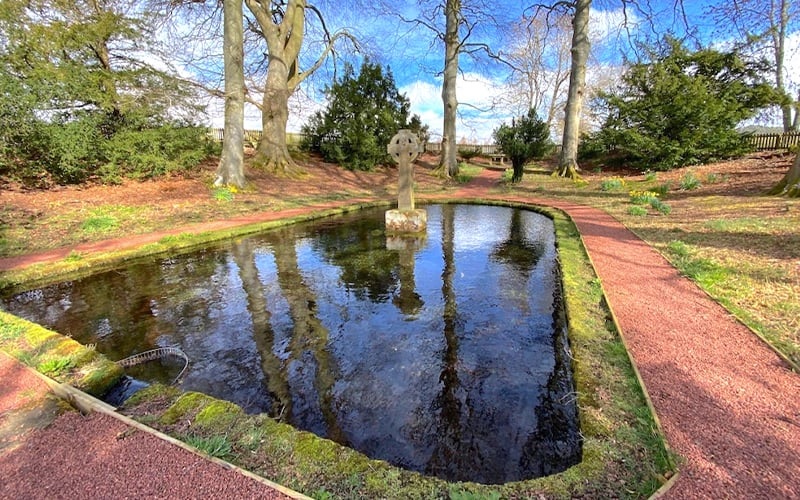


The ancient spring of Lady’s Well, situated in the tiny village of Holystone on the edge of Northumberland National Park. (Northumberland Traveller pic)
He goes on to list seven such mesmerising spots in Northumberland, namely Lady’s Well at Holystone; Heavenfield; The Holy Island of Lindisfarne; Bamburgh; The Inner Farne; Saint Wilfred’s Crypt; and Cuthbert’s Cave.
Lady’s Well is an ancient spring situated in the tiny village of Holystone on the edge of Northumberland National Park. It is thought that the Romans built a low retaining wall around this natural spring, creating the rectangular pool shape that can be seen today.
This would have served as a source of refreshment, and possibly a shrine, for travellers on the Roman road from Bremenium in Redesdale to the coast.
The Celtic cross in the centre of the pond was erected in the 19th century. Its inscription commemorates St Paulinus, a 7th-century Roman monk who was sent by Pope Gregory I to convert the heathen Brits to Christianity. It reads: “In this place Pavlinus the Bishop baptised three thousand Northvmbrians – Easter DCXXVII”.
 The Victorian-era St Mary the Virgin church still stands today. (Northumberland Traveller pic)
The Victorian-era St Mary the Virgin church still stands today. (Northumberland Traveller pic)
It is hard to imagine 3,000 people gathered in this remote and sparsely populated corner of Northumberland in AD 627. Nowadays visitors will likely have the place to themselves.
A medieval statue of St Paulinus usually stands at one end of the pool, but it was unfortunately damaged by falling trees during Storm Arwen in November 2021 and taken away for repair.
The flat stone on which the statue stands/stood is possibly the Holy Stone that he knelt on, which gave the village its name.
Saint Ninian, the fifth-century Celtic apostle of the Borders, is also associated with the well pool and is said to have baptised converts here.
The name “Lady’s Well” came into use in the 1100s when Holystone became the home of a priory of Augustinian canonesses dedicated to St Mary the Virgin. No doubt the nuns would have benefited from pilgrims visiting the holy well.
The nunnery is long gone – though some of its remains were unearthed in 2015 – but the village does have a small church called St Mary the Virgin.
 St Mungo’s Well at Holystone is one of two sources of water in this charming village. (Northumberland Traveller pic)
St Mungo’s Well at Holystone is one of two sources of water in this charming village. (Northumberland Traveller pic)
It is a mostly Victorian-era structure with a few fragments of its 12th-century predecessor remaining. The interior is simple, calm and peaceful, enhanced by colourful stained glass windows.
The well remains the source of the village’s water supply, so visitors are requested not to contaminate it in any way.
There is another well in the village, St Mungo’s Well. Give the water from the trickling tap a sip, and you will find it tastes quite different from the usual tap water.
Perhaps an enterprising villager could bottle and sell St Mungo’s and Lady’s Well holy water for its spiritual and health-giving benefits.
All in all, you might not get a sense of being in a “thin place” at Lady’s Well, but it’s certainly an atmospheric spot that’s “well” worth a visit.
 Woodhouses Bastle, a defensible farmhouse built during the 16th and 17th centuries. (Northumberland Traveller pic)
Woodhouses Bastle, a defensible farmhouse built during the 16th and 17th centuries. (Northumberland Traveller pic)
A short drive from Holystone is Woodhouses Bastle. This is one of the best-surviving examples of a bastle house, a defensible farmhouse built in response to the warring conditions that existed in the Borders during the 16th and 17th centuries.
The word “bastle” comes from the French “bastille”, meaning stronghold. Typically bastles had two floors, while Pele towers usually had three storeys.
Wealthier families would keep their sheep and cattle on the lower floor to protect them from “reivers” (robbers), while the family lived on the upper floors.
This article first appeared on Northumberland Traveller.






